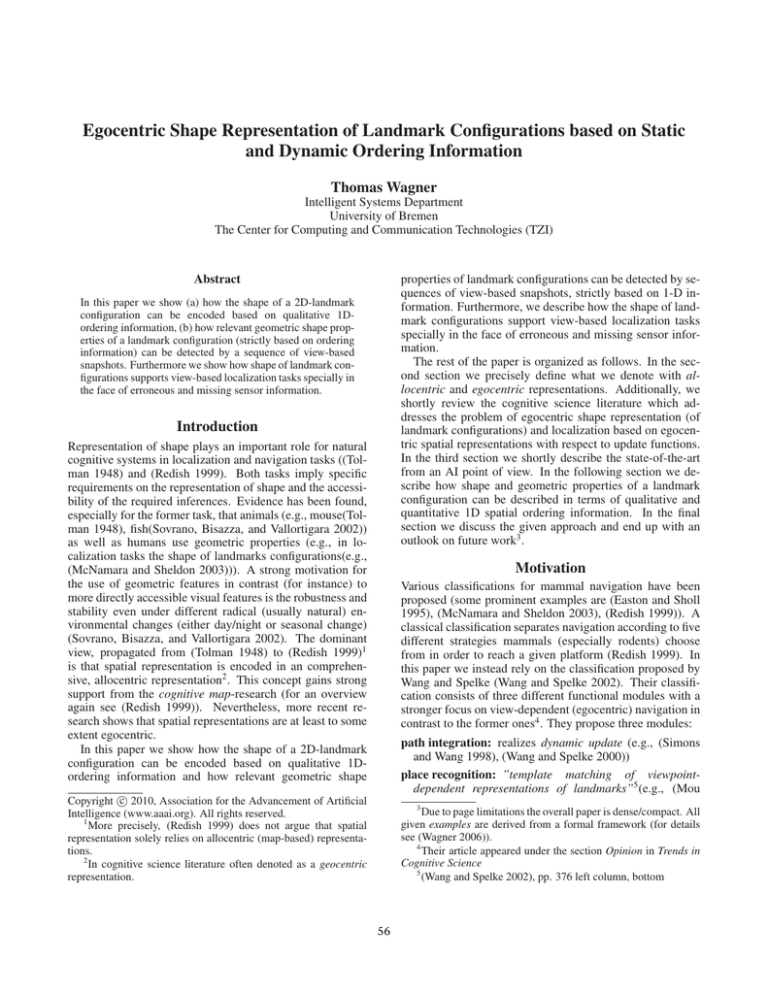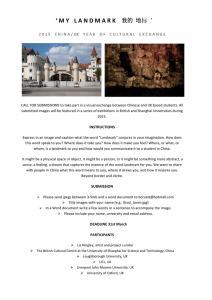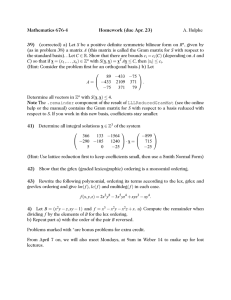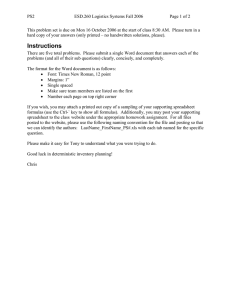
Egocentric Shape Representation of Landmark Configurations based on Static
and Dynamic Ordering Information
Thomas Wagner
Intelligent Systems Department
University of Bremen
The Center for Computing and Communication Technologies (TZI)
properties of landmark configurations can be detected by sequences of view-based snapshots, strictly based on 1-D information. Furthermore, we describe how the shape of landmark configurations support view-based localization tasks
specially in the face of erroneous and missing sensor information.
The rest of the paper is organized as follows. In the second section we precisely define what we denote with allocentric and egocentric representations. Additionally, we
shortly review the cognitive science literature which addresses the problem of egocentric shape representation (of
landmark configurations) and localization based on egocentric spatial representations with respect to update functions.
In the third section we shortly describe the state-of-the-art
from an AI point of view. In the following section we describe how shape and geometric properties of a landmark
configuration can be described in terms of qualitative and
quantitative 1D spatial ordering information. In the final
section we discuss the given approach and end up with an
outlook on future work3 .
Abstract
In this paper we show (a) how the shape of a 2D-landmark
configuration can be encoded based on qualitative 1Dordering information, (b) how relevant geometric shape properties of a landmark configuration (strictly based on ordering
information) can be detected by a sequence of view-based
snapshots. Furthermore we show how shape of landmark configurations supports view-based localization tasks specially in
the face of erroneous and missing sensor information.
Introduction
Representation of shape plays an important role for natural
cognitive systems in localization and navigation tasks ((Tolman 1948) and (Redish 1999). Both tasks imply specific
requirements on the representation of shape and the accessibility of the required inferences. Evidence has been found,
especially for the former task, that animals (e.g., mouse(Tolman 1948), fish(Sovrano, Bisazza, and Vallortigara 2002))
as well as humans use geometric properties (e.g., in localization tasks the shape of landmarks configurations(e.g.,
(McNamara and Sheldon 2003))). A strong motivation for
the use of geometric features in contrast (for instance) to
more directly accessible visual features is the robustness and
stability even under different radical (usually natural) environmental changes (either day/night or seasonal change)
(Sovrano, Bisazza, and Vallortigara 2002). The dominant
view, propagated from (Tolman 1948) to (Redish 1999)1
is that spatial representation is encoded in an comprehensive, allocentric representation2 . This concept gains strong
support from the cognitive map-research (for an overview
again see (Redish 1999)). Nevertheless, more recent research shows that spatial representations are at least to some
extent egocentric.
In this paper we show how the shape of a 2D-landmark
configuration can be encoded based on qualitative 1Dordering information and how relevant geometric shape
Motivation
Various classifications for mammal navigation have been
proposed (some prominent examples are (Easton and Sholl
1995), (McNamara and Sheldon 2003), (Redish 1999)). A
classical classification separates navigation according to five
different strategies mammals (especially rodents) choose
from in order to reach a given platform (Redish 1999). In
this paper we instead rely on the classification proposed by
Wang and Spelke (Wang and Spelke 2002). Their classification consists of three different functional modules with a
stronger focus on view-dependent (egocentric) navigation in
contrast to the former ones4 . They propose three modules:
path integration: realizes dynamic update (e.g., (Simons
and Wang 1998), (Wang and Spelke 2000))
place recognition: ”template matching of viewpointdependent representations of landmarks”5 (e.g., (Mou
c 2010, Association for the Advancement of Artificial
Copyright Intelligence (www.aaai.org). All rights reserved.
1
More precisely, (Redish 1999) does not argue that spatial
representation solely relies on allocentric (map-based) representations.
2
In cognitive science literature often denoted as a geocentric
representation.
3
Due to page limitations the overall paper is dense/compact. All
given examples are derived from a formal framework (for details
see (Wagner 2006)).
4
Their article appeared under the section Opinion in Trends in
Cognitive Science
5
(Wang and Spelke 2002), pp. 376 left column, bottom
56
and McNamara 2002))
remains an open question how view-based navigation will
under more dynamic conditions. In this paper we propose
that a 1-D ordering representation of shape of landmark configurations provides an appropriate frame of reference that
allows to give answers to the given problems.
reorientation system: ”operates by congruence-finding on
representations of the shape of the surface layout”6 (e.g.,
(Mou, Zhang, and McNamara 2004), (Mou et al. 2004))
Consistent with recent research in cognitive science (e.g.,
(Easton and Sholl 1995), (Wang and Brockmole 2003),
(May 2004)) they propose an egocentric approach to mammal navigation7 . In this paper we try to follow this general pattern. We describe an approach to egocentric navigation and show how the three modules can be realized based
strictly on qualitative and quantitative 1-D spatial information.
Allocentric and egocentric approaches to navigation differ significantly from each other. They focus on different
types of spatial relations, i.e., egocentric and allocentric relations. More precisely, egocentric and allocentric relations
can be defined like follows. Let Θ denote the set of physical
objects and A a cognitive agent with A ∈ Θ. Additionally,
RSP denotes the set of spatial relations which are perceived
by Apra . A binary relation Rego ∈ RSP is an egocentric relation iff Rego ⊆ Apra ×α, mit α ∈ Θ. Contrawise, a binary
relation Rallo ∈ RSP is called allocentric iff Rallo ⊆ β ×α,
mit β, α ∈ Θ. Therefore, a spatial representation is called
allocentric iff all relation Rallo ∈ Rspa are allocentric (and
accordingly for an egocentric representation).
Furthermore, allocentric8 and egocentric approaches to
navigation differ significantly from an operational point of
view. Allocentric spatial representations are usually harder
to retrieve due to the transformation process from egocentric sensor inputs into an allocentric representation (more
details in the following sections). Although this task can be
solved by use of different specialized modules e.g., by specialized cells (head direction cells) it still remains a complex
task9 . However, once generated an allocentric representation provides a stable FoR for localization tasks (i.e., egocentric as well as allocentric relations can be derived with
limited effort). In contrast egocentric representations (i.e.,
(Schoelkopf and Mallot 1995) developed a concept for (egocentric) snapshots-based localization) can be used directly
without any transformation. Instead it requires a continuous
update of all relevant (egocentric) spatial relation in case of
movement. Although the number of egocentric spatial relation in a given environment is strictly less in contrast to allocentric relations, complexity arises due to the continuous
nature of the update process. An additional critical problem
is the selection of appropriate significant egocentric snapshots and the mapping between different snapshots, e.g., in
terms of path integration. Although it has been shown that
even a simple pixel-based similarity measure can be sufficient in small environments under static conditions it still
Navigation based on ordering information
The first approach to qualitative navigation based on ordering information has been introduced by Levitt and Lawton
(Levitt and Lawton 1990). They propose a genuine qualitative approach to navigation that does not rely on any additional quantitative spatial information and supports navigation strictly based on qualitative information10
Figure 1: Localization by Ordering Information (Adopted
from Schlieder (Schlieder93))
They introduced a three level spatial representation with
different levels of abstraction. Only on the highest level spatial knowledge was represented strictly qualitative. Based
on an omnidirectional sensor, they assumed that the egocentric 1-D ordering of landmarks which results from a roundview is sufficient to localize a robotic agent. Since the ordering does neither relies on metric distance information
nor on metric angular information it can be assumed to be
rather robust. However, although this idea has a strong intuitive appeal it does not hold in general. Given the position of the robotic agent is indicated by the black dot in figure 1, they assumed that the position can be described by
the circular ordering ..., L1 , L2 , L3 , L4 , L5 , ... of the landmarks. Figure 1 (adopted from Schlieder (Schlieder 1993))
is a simple counter example for this assumption. Each
gray marked region is described by the same circular ordering ..., L1 , L2 , L3 , L4 , L5 , ... and can therefore not be distinguished (for a detailed formal analysis see Schlieder).
Therefore, the direct use of ordering information as it was
proposed by Levitt and Lawton cannot be used for precise,
qualitative localization in general.
Schlieder proposed a different spatial representation, the
panorama representation which overcomes the described
problems of Levitt and Lawton11 . In Schlieder’s approach
6
(Wang and Spelke 2002), pp. 376 left column, bottom
They do neither claim that map-based navigation does not exist
nor that the cognitive map is irrelevant in mammal navigation tasks.
8
In this paper we use the term allocentric synonym to mapbased although both terms have a different focus.
9
In this paper we do not consider the role of different egocentric
frames of reference (FoR). For more details see, e.g., (Pouget et al.
2002).
7
10
Nevertheless, their navigation architecture does not solely rely
on qualitative navigation.
11
The concept of panorama representation has been studied extensively in the course of other domains like specialized sensors
57
a complete, circular panorama can be described as a 3600
view from a specific, observer-dependent point of view. Let
P in figure ?? denote a person, then the panorama can be
defined by the strict ordering of all objects: house, woods,
mall, lake. This ordering information, however, does not
only contain all ordering information as described by the
scenario ??. The mall is not only directly between the woods
and the lake, but more specifically between the opposite side
of the house and the lake (indicated by the tails of the arrows). In order to represent the spatial knowledge described
in a panorama scenario, Schlieder (Schlieder 1996) introduced a formal model of a panorama.
LOrth(PΓ /SP ) from the position of PΓ .13
Definition: (Panorama) Let Θ= {θ1 , . . . , θ2 } be a set of
points θ ∈ Θ and Φ = {φ1 , . . . , φn } the arrangement of
n-1 directed lines connecting θi with another point of Θ,
then the clockwise oriented cyclical order of Φ is called
the panorama of θi .
Figure 2: Construction of an ordering snapshot S based on
a triple landmark configuration A, B, C
The panorama approach provides a qualitative spatial representation which is strictly based on ordering information
that also has been proven to be correct in any environment.
Nevertheless the application in practical domains can be a
rather difficult. The key problem to be solved is to determine
the exact ordering with respect to opposite sides of landmarks. unfortunately they can never be perceived directly
but instead require quite precise quantitative data in order
to calculate the ordering, especially in scenarios with many
landmarks. In (Wagner 2006) Wagner propose an approach
that does not rely on opposite landmarks but is restricted
to localization tasks outside the convex hull of landmark
configurations. We show how this approach and a quantitative extension in terms of relative (qualitative) speed and
acceleration can also be used to describe and distinguish the
shape landmark configurations. Additionally, we describe
how qualitative shape is able to provide a stable and robust
frame of reference for navigation tasks.
At least three interesting questions are arising:
1. To which extent is the perception of an ordering snapshot
determined by the (geometric) shape of the landmarks
configuration?
2. Is it possible to define a simple similarity metric for egocentric snapshots?
3. Can shape be described by sequences of ordering snapshots? - Additionally, can qualitative shape be used to
guide the continuous update process?
First, we have to investigate the relations between position, landmark configuration shape and ordering perception.
Assume landmark configuration LCqrps with an rectangle
layout based on the landmarks q,r,p and s. The relative position of an observer with respect to LCqrps is given by the
active ordering snapshot. Assume the position of the observer is given by Γ (indicated by the small circle in figure
3). The resulting ordering snapshot at the given position of
Γ is given by S LCqrps = pqrs.
Qualitative Shape by Ordering Information
The use of qualitative ordering information is based on two
fundamental assumptions:
1. three-dimensional landmarks can be interpreted as abstract(mathematical) points12
2. qualitative ordering information can be abstracted from
quantitative sensor input
An ordering snapshot S is defined as a strictly ordered sequence of point-like objects perceived by a given cognitive
agent. The construction process is described in figure 2. Assume a landmark configuration A, B, C and an observer
PΓ outside the convex hull of A, B, C. Furthermore, assume a viewpoint SP within the convex hull of A, B, C
which can be seen by PΓ and the orthogonal LOrth(PΓ /SP )
of the line of sight from SP to PΓ . The snapshot S is constructed by the projection of the landmarks A,B and C on
Figure 3: Landmark and position transitions based on a convex rectangle landmark configuration LCqrps
(e.g., omnivision, see, e.g., (Zheng and Tsuji 1992)).
12
In practice the (re-)identification of three-dimensional landmarks can difficult specially with changing perspectives.
13
Alternatively, ordering information can be defined in terms of
qualitative triangle orientations.
58
S LCqrps will remain stable until Γ crosses either the
line q/p or r/s. In the latter case S LCqrps will change
to S LCqrps = pqsr due to a landmark switch between landmark s and r (by crossing r/s). The circular navigation around LCqrps (outside the convex hull)
will therefore result in a sequence of ordering snapshots
LC
LC
SSeq = S1 qrps ,. . . ,Sj qrps .
Figure 5: All differing convex landmark configuration
shapes that can be distinguished by full sequences of ordering snapshots
configuration and observes three times the following sequence of landmarks transitions (without identification) between position 1/2, 2/3 and 3/4, it is clear that the given
landmarks form a parallelogram configuration. The shape of
a landmark configuration can even be determined based on a
sequence of limited ordering snapshot, i.e., the perception of
transitions q/s, p/s, . . . (see figure 3 for the full sequence)
is also sufficient (in this case we do not need to know the
ordinal position of the landmarks under transition, e.g., a
switch between the first and second position). The sequence
of possible transitions sequences as well as the sequence of
all possible position transitions can be calculated in advance
(see figure 6).
Figure 4: Landmark and position transitions of a nonparallel oriented quad-tuple landmark configuration
How does SSeq depend on the specific shape of the landmark configuration? Figure 4 shows an example with a
quad-tuple landmark configuration LCqrps
with different
shape and a different ordering sequence S LCqrps . Again assume that the position of the observer (in figure 4) is given
by the circular object denoted with Γ. The ordering snapshot
at this position is given by S LCqrps = psqr. In contrast to
LCqrps in figure 3 there are two regions where the observer
has a choice where to pass the line in (counter-clockwise)
navigation. From S LCqrps observer Γ can either pass the
line 3/4 towards region spqr or towards region psrq.
The latter region denoted by psrq does not exist in figure
3. The additional region emerges as a result of the intersection of line q/r (3/4 in figure 3) with line p/s (1/2 in
figure 3). Generally, each intersection of lines results in a
new region but the possible locations of line intersections
are not arbitrary. E.g., it is geometrically impossible to create a new region (intersection) at the opposite side line q/r
and line p/s since two straight line can only intersect once14 .
In the case of quad-tuple landmark configurations nine different landmark configuration shapes can be distinguished
by different SSeq (f igure5).
The full sequence of ordering snapshots already contains
redundant information with respect to the classification of
different landmark configurations shapes. Even in the case
when the observer is not able to distinguish the landmarks,
the sequence of landmark positions transitions is already
sufficient to determine landmark configuration shape. Given
the observer walks counter-clockwise around a landmark
Figure 6: Complete ordering-transition-graph for counterclockwise navigation
Discussion
In the beginning of the last section we asked three question
according to the role and representation of shape (of landmark configurations) based on ordering information:
At top of figure 3 an additional region has emerged srqp For a full formal specification (with proofs and theorems) please
refer to (Wagner 2006).
14
1. To which extent is the perception of an ordering snapshot
59
determined by the (geometric) shape of the landmarks
configuration?
May, M. 2004. Imaginal Perspective switches in remenbered Environments: Transformation vs. Interference Accounts. Cognitive
Psychology Vol. 48:pp. 163–206.
McNamara, T., and Sheldon, A. 2003. Cognitive Maps and the
Hippocampus. Trends in Cognitive Science Vol. 7(8):pp. 333–
335.
Mou, W., and McNamara, T. 2002. Intristic Frames of Reference in Spatial Memory. Journal of Experimental Psychology:
Learning, Memory and Cognition Vol. 28(1):pp. 162–170.
Mou, W.; McNamara, T.; Valiquette, C.; and Rump, B. 2004. Allocentric and Egocentric Updating of Spatial Memories. Journal
of Experimental Psychology: Learning, Memory and Cognition
Vol. 30(1):pp. 142–157.
Mou, W.; Zhang, K.; and McNamara, T. 2004. Frames of Reference in Spatial Memories Aquired from Language. Journal of
Experimental Psychology: Learning, Memory and Cognition Vol.
30(1):pp. 171–180.
Pouget, A.; Ducon, J.-C.; Torri, J.; and Bavelier, D. 2002. Multisensory Spatial Represenations in Eye-Centered Coordinates for
Reaching. Cognition Vol. 83:pp. B1–B11.
Redish, A. 1999. Beyond the Cognitive Map - From Place Cells
to Episodic Memory. The MIT Press, Cambridge, Mass.
Schlieder, C. 1993. Representing Visible Locations for Qualitative Navigation. In: Qualitative Reasoning and Decision Technologies, N. Piera-Carrete & M. Singh (Eds.) CIMNE Barcelona.
pp. 523–532.
Schlieder, C. 1996. Intelligent Image Database Systems. Singapore: World Scientific Publishing. chapter Ordering Information
and Symbolic Projection, pp. 115–140.
Schoelkopf, B., and Mallot, H. A. 1995. View-Based Mapping
and Path Planning. Adaptive Behavior Vol. 3(3):pp. 311–348.
Simons, D., and Wang, R. 1998. Percieving Real-World Viewpoint Changes. Psychological Science Vol. 9(4):pp. 315–321.
Sovrano, V.; Bisazza, A.; and Vallortigara, G. 2002. Modularity
and Spatial Reorientation in a Simple Mind: Encoding of Geometric and Nongeometric Properties of a Spatial Environment by
Fish. Cognition Vol. 85:pp. B51–B59.
Tolman, E. 1948. Cognitive Maps in Rats and Men. Psycholoical
Review Vol. 55:pp. 189–208.
Wagner, T. 2006. Qualitative sicht-basierte Navigation in unstrukturierten Umgebungen. Ph.D. Dissertation, Universitaet Bremen, TZI.
Wang, R., and Brockmole, J. 2003. Human Navigation in Nested
Environment. Journal of Experimental Psychology: Learning,
Memory and Cognition Vol. 29(3):pp. 398–404.
Wang, R., and Spelke, E. 2000. Updating Egocentric Represenations in Human Navigation. Cognition Vol. 77:pp. 215–250.
Wang, R., and Spelke, E. 2002. Human Spatial Representation:
Insights from Animals. Trends in Cognitive Science Vol. 6(9):pp.
176–182.
Zheng, J., and Tsuji, S. 1992. Panoramic pp. Representation for
Route Recognition by a Mobile Robot. International Journal of
Computer Vision Vol. 9(1):pp. 55–76.
2. Is it possible to define a simple similarity metric for egocentric snapshots?
3. Can shape be described by a sequence of ordering snapshots? - Can it be used for continuous update?
The first question can be answered precisely: Ordering information, i.e., the egocentric perceived ordering of
landmarks (egocentric snapshot) is tightly coupled to the
shape of a given landmark configuration. Figure 4 describes
all possible egocentric snapshots for every possible convex
quad-tuple landmark configuration that can be distinguished
strictly based on ordering information. Every possible variation is precisely (pre-)defined.
The answer to the second question is more complex. First,
an egocentric snapshot implicitly defines a similarity measure in terms of the number equal ordering relations between
two egocentric snapshots (e.g., number of equal leftOf relations). Problems can arise since the number of equal relations does not directly contribute to metric distances, e.g.,
in figure 3 the distance between different regions/transitions
can differ significantly and will therefore not always lead
to an intuitive distance estimation. Notwithstanding, ordering provides a more stable measure than e.g., pixel similarity (see (Schoelkopf and Mallot 1995)). It has been shown
that ordering perception strictly depends on the shape of the
landmark configuration and therefore, it is less sensitive to
environmental changes like lighting conditions or seasonal
changes (in natural environments).
In turn, the answer to questions three is once again clear.
Figure 4 describes precisely (also) all possible transitions
either based on landmark identification or based on the given
positional changes of landmarks (without identification). An
advantage of ordering information is that it does not require
a real continuous update since the changes are discrete and
do not appear immediately. In addition, all transitions are
known in advance with respect to the shape of the landmark
configuration and the direction of navigation of the cognitive
agent.
Although we believe that ordering information may play
a crucial role in egocentric shape representation we also believe that other spatial information will also play an important role. E.g., in the process of ordering perception almost
every sensor will additionally perceive the direction of landmark movement (either towards- or away from each other).
Furthermore, absolute as well as relative speed of landmark
movement in addition to acceleration (qualitative and quantitative) will allow for a more precise description of landmark configurations shape. Moreover this information can
easily be combined with ordering snapshots.
References
Easton, R., and Sholl, M. 1995. Object-Array Structure, Frames
of Reference, and Retrieval of Spatial Knowledge. Journal of
Experimental Psychology: Learning, Memory and Cognition Vol.
21(2):pp. 483–500.
Levitt, T. S., and Lawton, D. T. 1990. Qualitative Navigation for
Mobile Robots. Artificial Intelligence Vol. 44(3):pp. 305–360.
60










